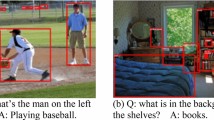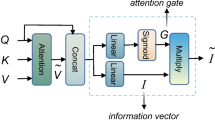Abstract
Recently, visual question answering (VQA) based on the feature fusion between image vision and question text has attracted considerable research interests. The attention mechanism and dense iterative operations are adopted for fine-grained interplay and matching by aggregating the similarities of the image region and question word pairs. However, the autocorrelation information of image regions is ignored, which will lead to deviation in overall semantic understanding, thereby reducing the accuracy of answer prediction. Moreover, we notice that some valuable but unattended edge information of image is often completely forgotten after multiple bilateral co-attention operations. In this paper, a novel Compound-Attention Network with Original Feature injection is proposed to leverage both bilateral information and autocorrelation in a holistic deep framework. A visual feature enhancement mechanism is designed to mine more complete visual semantics and avoid understanding deviation. Then, an original feature injection module is proposed to retain the unattended edge information of the image. Extensive experiments conducted on VQA2.0 database demonstrate the effectiveness of the proposed method.








Similar content being viewed by others
References
Savchenko, A.V.: Event recognition with automatic album detection based on sequential processing, neural attention and image captioning. In: Computer 2020 International Joint Conference on Neural Networks (IJCNN), pp. 1–8 (2020). https://doi.org/10.1109/IJCNN48605.2020.9207675
Anderson, P., He, X., Buehler, C., et al.: Bottom-up and top-down attention for image captioning and VQA. In: Proceedings of the IEEE Conference on Computer Vision and Pattern Recognition, pp. 6077–6086 (2018)
Zhang, Y., Lu, H.: Deep cross-modal projection learning for image-text matching. In: ECCV Conference on Lecture Notes in Computer Science, pp. 707–723 (2018)
Cha, M., Gwon, Y.L., Kung, H.T.: Adversarial learning of semantic relevance in text to image synthesis. In: National Conference on Artificial Intelligence, vol. 33, pp. 3272–3279 (2019)
Kim, H.H., Park, J.S., Jung, J.W., et al.: Immersive teleconference system based on human–robot–avatar interaction using head-tracking devices. Int. J. Control Autom. Syst. 11, 1028–1037 (2013)
Gao, P., Jiang, Z., You, H., et al.: Dynamic fusion with intra- and inter-modality attention flow for visual question answering. In: Computer Vision and Pattern Recognition, pp 6639–6648 (2019)
Fukui, A., Park, D.H., Yang, D., et al.: Multimodal compact bilinear pooling for visual question answering and visual grounding. In: Empirical Methods in Natural Language Processing, pp. 457–468 (2016)
Teney, D., Anderson, P., He, X., et al.: Tips and tricks for visual question answering: Learnings from the 2017 challenge. In: Computer Vision and Pattern Recognition, pp. 4223–4232 (2018)
Nguyen, D.K., Okatani, T.: Improved fusion of visual and language representations by dense symmetric co-attention for visual question answering. In: IEEE/CVF Conference on Computer Vision and Pattern Recognition, pp. 6087–6096 (2018)
Gao, Y., Beijbom, O., Zhang, N., et al.: Compact bilinear pooling. In: Computer Vision and Pattern Recognition, pp. 317–326 (2016)
Kim, J.H. , On, K.W. , Lim, W., et al. Hadamard product for low-rank bilinear pooling. In: Computer Vision and Pattern Recognition (2016)
Yu, Z., Yu, J., Fan, J., et al.: Multi-modal factorized bilinear pooling with co-attention learning for visual question answering. In: IEEE International Conference on Computer Vision, pp. 1839–1848 (2017)
Mohammadi, S., Majelan, S.G., Shokouhi, S.B.: Ensembles of deep neural networks for action recognition in still images. In: International Conference on Computer and Knowledge Engineering, pp. 315–318 (2019)
Gao, J., He, T., Zhou, X., et al.: Focusing and diffusion: Bidirectional attentive graph convolutional networks for skeleton-based action recognition. In: Computer Vision and Pattern Recognition (2019)
Nuthakki, S., Neela, S., Gichoya, J.W., et al.: Natural language processing of mimic-iii clinical notes for identifying diagnosis and procedures with neural networks. In: Computation and Language (2019)
Das, A., Verma, R.: Automated email generation for targeted attacks using natural language. In: Computation and Language (2019)
Ilija, I., Yan, S., Feng, J.: A focused dynamic attention model for visual question answering. In: Computer Vision and Pattern Recognition (2016)
Damron, M., Hanson, J., Houdré, C., et al.: Lower bounds for fluctuations in first-passage percolation for general distributions. In: Probability (math.PR) (2018)
Lee, H., Huang, C., Yune, S., et al.: Machine friendly machine learning: interpretation of computed tomography without image reconstruction. Sci. Rep. 15540, 1300–1309 (2019)
Chen, Z., Zhao, Y., Huang, S., et al.: Structured attentions for visual question answering. In: International Conference on Computer Vision, vol. 1, pp. 1300–1309 (2017)
Kim, J., Lee, S., Kwak, D., et al.: Multimodal residual learning for visual QA. In: Neural Information Processing Systems, pp. 7–13 (2016)
Yang, Z., He, X., Gao, J., et al.: Stacked attention networks for image question answering. In: IEEE Conference on Computer Vision and Pattern Recognition, vol. 1, pp. 21–29 (2016)
Kim, S., Choi, H.: Convolutional neural network for monocular vision-based multi-target tracking. Int. J. Control Autom. Syst. 17, 2284–2296 (2019)
Goyal, Y., Khot, T., Agrawal, A., et al.: Making the v in vqa matter: elevating the role of image understanding in visual question answering. In International Journal of Computer Vision, vol. 127 (2019). https://doi.org/10.1007/s11263-018-1116-0
Pennington, J., Socher, R., Manning, C.: Glove: global vectors for word representation. Empir. Methods Nat. Lang. Process. 14, 1532–1543 (2014)
He, K., Zhang, X., Ren, S.: Deep residual learning for image recognition. In: IEEE Conference on Computer Vision and Pattern Recognition, vol. 1, pp. 770–778 (2016)
Srivastava, N., Hinton, G., Krizhevsky, A., et al.: Dropout: a simple way to prevent neural networks from overfitting. J. Mach. Learn. Res. 15, 1921–1958 (2014)
Yu, Z., Yu, J., Xiang, C., et al.: Beyond bilinear: generalized multi-modal factorized high-order pooling for visual question answering. IEEE Trans. Neural Netw. Learn. Syst. 99, 1–13 (2017)
Acknowledgements
This work is supported by the grants from Key Research and Development Plan of Shandong Province (No. 2019GGX101015), the Major Scientific and Technological Projects of CNPC under Grant ZD2019-183-001, the Fundamental Research Funds for the Central Universities (No. 20CX05018A), and the China National Study Abroad Fund.
Author information
Authors and Affiliations
Corresponding author
Additional information
Publisher's Note
Springer Nature remains neutral with regard to jurisdictional claims in published maps and institutional affiliations.
Rights and permissions
About this article
Cite this article
Wu, C., Lu, J., Li, H. et al. Compound-Attention Network with Original Feature injection for visual question and answering. SIViP 15, 1853–1861 (2021). https://doi.org/10.1007/s11760-021-01932-3
Received:
Revised:
Accepted:
Published:
Issue Date:
DOI: https://doi.org/10.1007/s11760-021-01932-3




